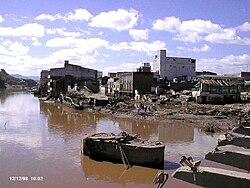IDA
The International Development Association's (IDA) portfolio in Honduras currently holds US $354 million in investments operating through a total nine lending operations spanning a variety of sectors in the region such as public sector management, citizen security, rural development, and social protection. Despite the promising potential that access to $300 has represented for the region, political risk within groundwork by the institution along with problems with implementation logistics have threatened to leave nearly US $100 million in assistance undisbursed with only 5 full-time projects being implemented, including the Improving Public Sector Performance project and the Rural Infrastructure Project, both of which have generally been classified as moderately unsatisfactory in their operation yet nonetheless seen as a positive trend with their relative increase in performance according to IDA standards.
IFC
Investments by the International Finance Corporation (IFC) in Honduras also include from $639.7 million in commitment to projects targeted toward Honduras' renewable energy sector, the expansion of the financial sector, and bolstering a competitive climate within agricultural business in rural communities. Operating as the second largest portfolio in Central America with over $630 million, Honduras has experienced growth through 29 successful public-private partnerships in infrastructure projects, as well as investments in four large scale renewable energy projects that are intended to help strengthen Honduras' electronic grid and assist in the development of a strong economy backed by a reliable infrastructure. [3] The IFC has received criticism for providing funding to the palm oil company Dinant due to allegations that the company has engaged in lethal attacks against several co-operatives. [4] The institution has also faced criticism over a 2011 $70m investment to Banco Ficohsa, Honduras' largest bank, with critics stating that the money would be indirectly supplied to Dinant. [5] [6] In a December 2013 audit the IFC's ombudsman found that the institution did not perform due diligence when examining the potential social and ecological risks associated with Dinant. [7]
However, in its 2015 report on Honduras, the International Criminal Court stated that "criminal organisations and international drug cartels are deeply involved in local businesses and criminal activities in the region and seem to be involved in most of the alleged crimes in the Bajo Aguán, including unlawful occupations of land and robbery of African palm fruits, in order to retain control of the region and to continue to operate in total impunity." [8]
A class action lawsuit was filed in March 2017 by the NGO EarthRights International on behalf of approximately a dozen anonymous farmers looking for compensation from the World Bank, who they claim “knowingly profiting from the financing of murder” by financing Dinant via the IFC. [9]
In October 2017, the IFC confirmed that Dinant had fully repaid the balance of its outstanding loan and that Dinant had achieved material compliance with IFC’s Performance Standards. The IFC also acknowledged that Dinant had made progress, particularly in implementing the Voluntary Principles on Security and Human Rights (VPSHR) security force protocols. [10]
In November 2017, Dinant defended its former relationship with the World Bank, stating, “The IFC’s loan to Dinant was granted to help us increase production capacity, upgrade our distribution network, enhance the surrounding natural environment, and expand economic opportunities for local communities, particularly in rural areas like the Aguán. Of course, we must continue to improve but, by all these measures and more, the IFC’s loan to Dinant has been a tremendous success. Dinant is now widely recognized as an international benchmark in how to operate a successful business transparently and honestly in one of the most challenging regions in the world.” [11]
MIGA
Operating through three major projects totaling over $US 326 million, the Multilateral Investment Guarantee, or MIGA has also brought potentially major changes in transport and energy sectors. Just recently, as of September 25, 2015, MIGA committed to $187 million in investment guarantees to support the construction of a major effort to connect San Pedro Sula, currently Honduras' 2nd largest city, and La Ceiba near its coast. [12] Honduras will potentially be able to manage more tourist traffic and support it with another MIGA-backed project granting over $80 million US dollars that will expand Honduras' current power grid capacity from 102 megawatts to 126 megawatts with the implementation of a wind farm and massive photovoltaic, (Solar power) projects. [13]



